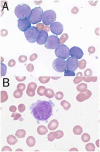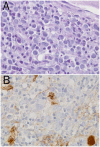Hematopoietic disorders in Down syndrome
- PMID: 18787621
- PMCID: PMC2480572
Hematopoietic disorders in Down syndrome
Abstract
Patients with Down syndrome have an increased risk of developing various hematological disorders. In this article, the clinical characteristics and differential diagnosis of the hematological disorders associated with Down syndrome are reviewed, and the underlying molecular mechanisms discussed.
Keywords: Down syndrome; acute leukemia; myelodysplastic syndrome; transient myeloproliferative disorder.
Figures




References
-
- Centers for Disease Control and Prevention. Improved national prevalence estimates for 18 selected major birth defects–United States, 1999–2001. MMWR Morb Mortal Wkly Rep. 2006;54:1301–1305. - PubMed
-
- Henry E, Walker D, Wiedmeier SE, Christensen RD. Hematological abnormalities during the first week of life among neonates with Down syndrome: Data from a multihospital healthcare system. Am J Med Genet A. 2007;143:42–50. - PubMed
-
- Hook EB, Cross PK, Schreinemachers DM. Chromosomal abnormality rates at amniocentesis and in live-born infants. JAMA. 1983;249:2034–2038. - PubMed
-
- Oudejans CB, Go AT, Visser A, Mulders MA, Westerman BA, Blankenstein MA, van Vugt JM. Detection of chromosome 21-encoded mRNA of placental origin in maternal plasma. Clin Chem. 2003;49:1445–1449. - PubMed
-
- Wataganara T, Bianchi DW. Fetal cell-free nucleic acids in the maternal circulation: new clinical applications. Ann N Y Acad Sci. 2004;1022:90–99. - PubMed
LinkOut - more resources
Full Text Sources
